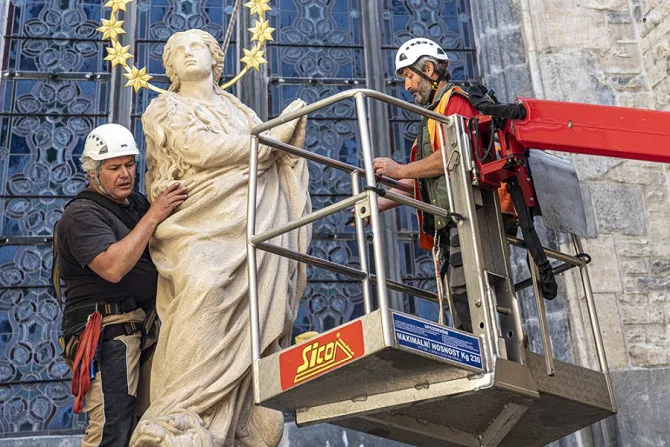Rome Newsroom, Jun 15, 2020 / 04:30 am
A historic statue of Mary atop a column, torn down by an angry crowd more than 100 years ago, has been restored to its original site in Prague.
The placement of the exact replica of the 17th-century statue in the Czech capital's Old Town Square June 4 was an event 30 years in the making.
The Marian column, as it is called, was erected to "the singing of Marian songs, the ringing of bells on the tower of the Mother of God in front of Týn [Church] and the applause of the people present," Karel Kavička told CNA via email.
Kavička is a founding member of an association of historians, artists, and Catholics who have worked for more than three decades to create the replica and to gain the city's permission to return the Marian column to its historic place.
"From the beginning, we have strived to make the pillar a symbol of reconciliation. Who can be a better symbol of peace than the Virgin Mary?" Kavička said.
He noted Czech Catholics' joy at the statue's restoration, but added that many Protestants and non-believers also supported the project because of the statue's historic and artistic importance in Prague.
The star-crowned Mary and the 52-foot column she sits upon were pulled down by a mob of angry men, led by writer Franta Sauer, on November 3, 1918.
The statue was erected by Habsburg Emperor Ferdinand III after the end of the Thirty Years' War in 1648, in thanksgiving for the end of the siege of Prague by the Swedish army.
After the collapse of the Catholic Austro-Hungarian Empire, the statue of the Virgin Mary "was presented as a political symbol, a symbol of the nation's enslavement," Kavička explained.
Jan Bradna, a sculptor and member of the Marian column association, told the BBC "it was the people of Prague" who had wanted the original statue, and "who lobbied the Habsburg Emperor Ferdinand III for permission to erect it."
After the establishment of Czechoslovakia as an independent republic in 1918, the Catholic Church became associated with the fallen monarchy and was defamed, Kavička said.
Petr Vana, the man who sculpted the replica Marian statue, told the BBC the toppling of the original took place because of a mob Sauer whipped up in a pub, and that "people didn't really hate the statue."
World War II and 40 years of communist regime followed, and since that time, Christian believers have been a minority in the Czech Republic, a largely atheistic country.
Kavička is a co-founder of the Society for the Restoration of the Marian Column on Old Town Square in Prague, which was established in April 1990, "immediately after the fall of the totalitarian communist regime."
For Kavička, because of his country's history, the re-erection of the Marian column represents "an opportunity for peace with the hope of a better future."
(Story continues below)
"We followed the initiatives of our ancestors, who sought to restore the column immediately after its demolition," he said. "These activities were interrupted by the Nazi occupation, World War II and then the communist regime. We promised ourselves that our initiative would be the last to fulfill the wishes of many generations."
Kavička, who has advanced degrees in philosophy and theology, is writing a book about the history and restoration of the Marian column.
He said he had no evidence that the man who led the tearing down of the statue in 1918, Franta Sauer, was Catholic, but it is believed he likely was, in part because he died in a Catholic monastery.
The end of Sauer's life is believed to be recounted in a historically based poem by Czech poet and playwright Václav Renč.
In The Prague Legend, Renč tells the story of the toppling of the Marian statue, led by an enthusiastic young bohemian artist named Oskar. The poem recounts Oskar's remorse for his actions, and tells that on his deathbed in a hospital run by Catholic sisters, he received a vision of the Virgin Mary and had a conversion of heart.
The statue of Mary now restored to Prague's Old Town Square is not the only one of its kind in the Czech Republic. Around the country there are "dozens of Marian columns in the squares of many cities," Kavička noted.
These Baroque-era -- and, in some cases, Renaissance-era -- statues "were built by the citizens and representatives of these cities to thank them for their protection in times of plague epidemics or to thank the Virgin Mary," Kavička said.



